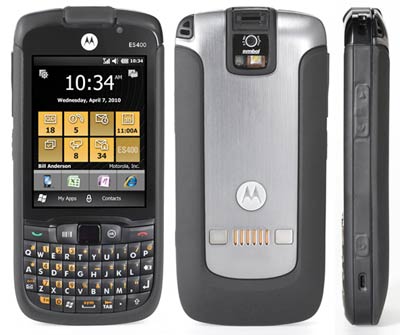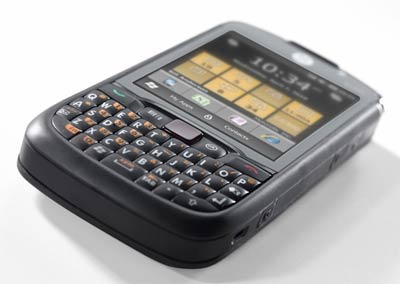On June 17, 2010, the Enterprise Mobility Solutions division of Motorola (why don't they just call it Symbol again?) introduced the ES400 Enterprise Digital Assistant. It is a somewhat ruggedized combination of phone and PDA, seeking to combine a variety of functions into one device.

In terms of size, the ES400 is fairly small, light, and handy. It measures 5.1 x 2.4 x 0.67 inches and weighs 5.5 ounces. That's larger and heavier than the iPhone class of smartphones, but significantly smaller and lighter than other recent combination devices such as the Datalogic Elf, Intermec's CN50, or Moto's own MC75A -- all thumb-type devices merging phone and a variety of data communications and capture functionality into one device.
The smaller size and weight, of course, means some trade-offs in terms of ruggedness and functionality. Motorola is aware of that and describes the ES400 as filling a gap between consumer and rugged devices. The ES400 is targeted at field sales, field service, retail, healthcare and any other place where workers want one device instead of several.
As is, the ES400 looks more like a beefier version of a BlackBerry than a conventional rugged handheld, thumb-type keyboard and all. Perhaps indicative of Marvell's seeming disinterest in the PXA processor line it took over from Intel a few years ago, the ES400 is based on a Qualcomm chip instead, the 600MHz version of the MSM 7627. This is a competent ARM11 processor, and here it's used in conjunction with Windows Mobile 6.5.3, albeit not with Microsoft's funky Zune-like interface, but Moto's own customizable MEUI (Motorola Enterprise User Interface) front end. You get 256MB of RAM and a gig of ROM, expandable via a microSDHC card slot.
The display measures three inches diagonally, a bit small, and smaller than that on many of today's digital cameras, but it has full VGA resolution (480 x 640 pixel) and it has a very bright (750+ nits) LED backlight. The digitizer is of the standard resistive variety, but provides tactile feedback.
On the wireless side, users can swap between 3.5G GSM HSPA and CDMA EVDO revA, covering the two major competing standards. There's also Bluetooth, 802.11a/b/g WiFi, GPS, a 3.2 megapixel camera with auto focus and illuminator, and a 3-axis accelerometer that's presumably used to provide some of the motion-sensing functionality expected from a modern smartphone. The camera, by the way, does double-duty as a 1D/2D barcode scanner. That works increasingly well, but in terms of speed and distance likely is no match for a dedicatd scanning module.
This being a device geared towards enterprise, Motorola added a built-in biometric fingerprint reader, compatibility with Motorola's Mobile Security Suite that provides device-level protection and mobile virtual private network functionality. The ES400 is also compatible with Motorola's Mobility Services Platform that enables centralized management of devices anywhere in the world, all from a single console.

On the ruggedness side of things, sealing is at a modest IP42 level, where the "4" means protection against solid objects over a millimeter in diameter, and the "2" means protected against direct sprays of water. We interpret that as the device not being dust-proof, but being able to handle a bit of rain every now and then. The ES400 can handle a 3-foot drop, and Moto also claims the full MIL-STD specified 26 drops at both the low and the high end of the operating temperature range, albeit only from three feet and onto vinyl-covered concrete. Combined with a decent "tumble" spec, the ES400 can probably handle being repeatedly dropped on the job. The 32 to 104 degree Fahrenheit operating range is decent, though there are many places where it can get both colder and hotter, and the little Moto's design seems able to ward off scratches and dents.
The larger issue here is whether Moto bet on the right horses. For example, most of Motorola's smartphones, including the red-hot Droid, use the Android OS whereas the ES400 uses the moribund Windows Mobile 6.5 with a custom front end. And while Moto's promotional videos suggest a degree of "swipe" functionality, the ES400 uses a conventional resistive touch screen at a time where the iPhone and its projected capacitive touch screen and superbly elegant interface have fundamentally changed expectations. Finally, the jury's out on whether users really want it all-in-one or whether they're just fine with carrying both a Droid or iPhone, and am industrial-strength rugged handheld. Only time will tell.



